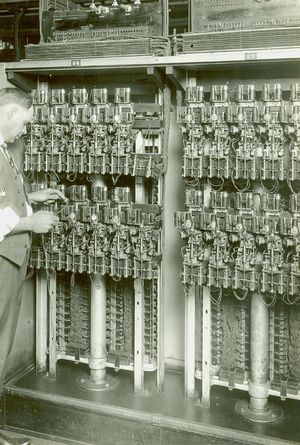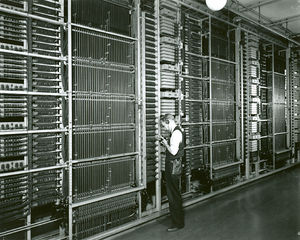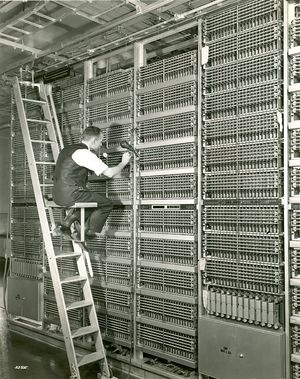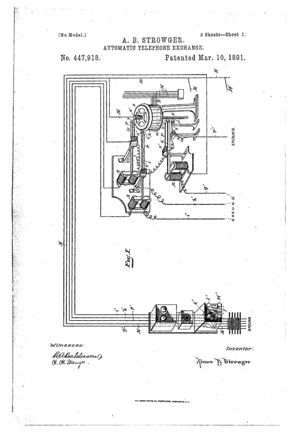Electromechanical Telephone-Switching
This article was initially written as part of the IEEE STARS program.
Citation
Originally, all telephone calls required the participation of an operator. This began to change when a crude automatic switch, invented by Almon Strowger, was improved into the first practical automatic switch around 1900. The application of Strowger switches, as well as panel, rotary, and crossbar switches, automated the telephone system. Automatic telephone switching was critical in making the telephone the influential mass market technology it became. It was also influential as an early and widespread example of automation of an electromechanical service.
Introduction
In January 1878, less than two years after Alexander Graham Bell of Boston, Massachusetts received his first patent for the telephone, the world’s first telephone exchange entered service in New Haven, Connecticut. Each of the twenty-one subscribers could call an operator at a central switchboard, who in turn could connect the subscriber to the desired subscriber. Within a decade, such telephone exchanges, with many improvements along the way, were in operation in nearly every city in the United States. These were under license from American Bell Telephone, the holder of Bell’s patents. There was similar, but somewhat later development in most of the developed world. Every telephone call required the assistance an operator or, as exchanges began to be connected to other exchanges, multiple operators. To a substantial extent, the story of innovations in telephony is an American story, in part because as late as the 1950s, the U.S. had more than half of the world’s telephones.
The Strowger Switch
In 1889, Almon Strowger applied for a U.S. patent (which was issued in 1891) for what would be the basis for the first practical automatic telephone switch. (Fig. 1) In the Strowger switch, pulses generated at a subscriber’s telephone directly moved electromagnetic contacts in a two-way motion in a stack of rotary contacts, thus selecting a telephone number, one digit at a time, without operator intervention. His original device was crude and impractical. Among other things, it had push buttons, and a subscriber had to, for example, push a button nine times to indicate a 9. A commonly told story explained that Strowger, an undertaker in Kansas City, was spurred to his invention by learning that the funeral of a friend was being handled by a competitor, whose family, Strowger was convinced, had been led to another undertaker by an unscrupulous telephone operator. Strowger and his backers formed a company, eventually known as the Automatic Electric Company, to develop the patent into a practical switch.
Under the technical leadership of Alexander E. Keith, Automatic Electric produced a steady series of significant advances, which together yielded a commercially viable system. Perhaps the most notable of these advances was the invention of the dial phone in 1896. (Fig. 2) By 1900, these much improved Strowger switches had entered commercial use in a relatively small number of independent (that is, non-Bell) exchanges in the U.S., typically in small or medium sized cities. Advocates promoted the switch as private; detractors called it a lower grade of service. Their use spread. By 1904, some four percent of independent lines were on automatic exchange.

In a Strowger switch, the subscriber’s dial directly controlled the movement of the switch contacts that established the circuit, and this circuit was maintained for the duration of the call. As the switch had a 10 x 10 bank of contacts, the earliest switch could handle only 100 telephones. The development of multilevel switching at Automatic Electric greatly increased the switch capacity, initially to 6,000 and ultimately 10,000 telephones. (Fig. 3) But the direct control of the switch by the subscriber remained an essential feature.
After 1910, Strowger switches began spreading to Europe. Additional improvements by Keith and others at Automatic Electric further improved the switch. By 1914, over 400,000 dial telephones were in use in the United States, 14 percent of the total phones in service. It was even adapted by Automatic Electric for the British Post Office to use in the largest British cities, beginning with London’s Holborn exchange in 1927. The Strowger, or step-by-step switch as it also became known, remained the most widespread switch in use until the 1960s, and it was particularly common in non-urban exchanges.
AT&T's Panel Switch
Although the large and well-established AT&T Bell System investigated automatic switching as early as 1903, it resisted adopting such switches for several reasons. Bell’s strength was in the nation’s large cities, with a large number of telephones and with a large percentage of calls requiring routing between exchanges within a city. Bell’s studies showed that Strowger switches were slower than AT&T’s improved manual switches in such applications. Also, Bell needed to make any switching innovations compatible with existing switches, as subscribers on any Bell automatic exchange would need to be able to efficiently contact subscribers still connected to manual exchanges.
AT&T and Western Electric, its equipment subsidiary, began research into alternative automatic switch designs better suited to urban needs. The first breakthrough was the invention of the translator by AT&T engineer Edward C. Molina in 1905. The translator, or the sender as an improved version would become known, introduced the concept of indirect control. That is, the pulses from the telephone dial would be translated into a different electromechanical code that could control a larger switching unit. This allowed for a subscriber’s telephone to select from a larger number of possible circuits, and for the separation of the circuit used to set up the call from the circuit used for the call itself. This in turn led to the preliminary development of two types of indirect control switches: the panel and the rotary. Both of these featured continuously running motors and clutches that engaged to select electrical contacts.
Around 1910, Western Electric transferred further work on the rotary switch to its European division, after determining that there was more interest in it among European government-run telephone companies. In Europe, the urban exchanges tended to have fewer telephones and therefore lesser interoffice trunking requirements. Various versions of the rotary switch entered service in large cities in Europe, chiefly after World War I. In the United States, Western Electric continued development of the panel switch, which was better suited for large cities with large volumes of interoffice calls. More than ninety percent of local calls in New York City involved phones connected to different local exchanges.
The panel switch was an extremely complex device, with tall panels covered with 500 rows of terminals. Each panel had an electric motor, to drive its (usually sixty) selectors by electromagnetically controlled clutches. The selector moved continuously rather than in steps, and the selectors establishing contact points could move a considerable distance. Separate frames were used for the several parts of the telephone-calling process.
The Bell System’s initial plan was for semiautomatic operation, where subscribers would still call operators, who in turn would enter the subscriber’s desired number. Two such semiautomatic switches were installed in Newark, New Jersey in 1915. But the Bell System soon decided to move to fully automatic switching, partly because growth in the number of telephones was making manual interoffice trunking more difficult and partly because of changing labor conditions. With the growth of the telephone network, the recruitment and employment of sufficient number of operators had become increasingly problematical.
The change to fully-automatic urban switching was made possible with a plan devised in 1916 by AT&T engineer W. G. Blauvelt. It allowed the transition to automatic dialing to take place without requiring every subscriber to get a new telephone number in addition to getting a new telephone with a dial. Blauvelt simply added letters to the numbers on the dial. Telephone numbers in large cities, such as New York, consisted of the exchange name and a 4-digit number. So instead of asking the operator for Pennsylvania 5000, the subscriber would dial PEN 5000. This also eased the connection between automatic and manual telephone exchanges, since the dialer could dial the entire number, and an operator could receive the number and know the manual exchange to which it should be forwarded.

AT&T installed its first panel switch in Omaha, Nebraska in December 1921, and its second in the Pennsylvania exchange of New York City in October 1922. By 1930 every telephone in Manhattan that connected to a central exchange was a dial telephone connected to a panel switch. (Fig. 4) Similar transitions occurred in major metropolitan areas throughout the country, but due to its cost, complexity, and high maintenance requirements, the panel switch was never adopted outside the United States.
For the operation of smaller, non-urban exchanges, AT&T in 1916 acquired a license from Automatic Electric to manufacture Strowger step-by-step switches, and also reached an agreement to purchase such switches. The first step-by-step switch in the Bell System entered service in Norfolk, Virginia in 1919.
AT&T's Crossbar Switch
AT&T began work on an alternative to the panel switch even before the first panel switch was installed. In 1913 J.N. Reynolds of Western Electric invented the crossbar selector, in which a small number of magnets operated a large number of relay contacts in a coordinate array. This meant that there were only small mechanical motions and none of the large sliding movements required in the panel and Strowger switches. However, the crossbar selector proved too expensive at this time to be put into use.
About the same time, Gotthief A. Betulander of Televerket, the Swedish postal, telegraph, and telephone administration, began working on an all relay switch. It, like the panel switch, had separate circuits for selection and connection. In 1918 Betulander learned of Reynold’s patent. Discovering that it required fewer relays, he combined it with the connection section of his design, thereby inventing the crossbar switch. He sold his invention to the Swedish company L. C. Ericsson, which had the resources to prepare it for manufacture. Ericsson was also developing its own variant of the rotary switch, the 500 switch, and in 1921 Televerket choose the latter for use in Swedish cities. However, Televerket did keep a version of the crossbar system alive, by using the crossbar selector in conjunction with Strowger switches in small rural exchanges, where they provided reliable service without on-site maintenance.
By the mid 1920s, the continued high costs of manufacturing, installing, and maintaining the panel switch had AT&T looking for an alternative design for large cities, but its researchers had not been able to produce a more cost-effective design. Then, in 1930, W. R. Mathies, of AT&T’s research-and-development division, now known as Bell Telephone Laboratories, visited Sweden, and there he saw the crossbar selectors in use in rural exchanges. Convinced that such selectors could be adapted to large switches, Mathies had his group resume work. After they rejected the idea of simply replacing the selectors on the existing panel design, they developed, beginning in 1934, an entirely new switch for urban use. The new switch used the crossbar as well as some of their work from earlier in the decade.

The first two crossbar switches went into service in 1938 in New York City. (Fig. 5) The crossbar switch achieved its goal of reducing costs for manufacturing and maintenance, and it had many innovative features that gave it a more flexible and adaptable design than panel or Strowger switches. An important feature was that the crossbar switch’s basic building block, the link relay frame, required only small movements throughout. Because of its overall flexibility, the urban crossbar was named the #1 crossbar, in anticipation of the development of crossbar switches for other applications.
The units used to establish a call were not only separate from those used for the actual call path, as they had been in the panel, but were common control units. This meant that all selector frames were accessible to all of the phones, and after a call they were released for use on other calls. These “markers” as they became known, were fast, thus reducing connection time.
Also significant was that the crossbar was the first switch where both the originating and terminating traffic were combined on the same set of line switches. This made possible simpler connections from telephones to the switches, and also allowed the crossbar to be adapted, as it soon was, for use in tandem switches, that is, specialized switches used to route calls between multiple urban exchanges. Crossbar tandems for the first time allowed for automatic alternative routing, when the direct route between exchanges was not available. Crossbar switches were wired to allow for the separation of the two directions of transmission. These features combined to make the switch very adaptable, easy to modify for both new applications and the addition of peripherals for new features.
Thus, it proved easy for Bell Labs to adapt the crossbar switch for use as the first automatic switch in the long distance network. Previously all long-distance calls required one or more operators at manual long distance switchboards; a subscriber dialed 211 to get a long distance operator. The first long distance crossbar switch, the #4 crossbar, was installed in Philadelphia, Pennsylvania in 1943. Four additional #4 crossbars were installed in other metropolitan areas in the next five years. (The project to produce the #2 crossbar was cancelled, and the designation "#3 crossbar" was skipped for reasons that remain unclear.)
Customer-dialed Long Distance
Equipping the U.S. telephone system for customer-dialed long distance calls required several additional innovations. There needed to be a nationwide numbering plan; the now-familiar standard of 3-digit area code plus 7-digit digit local number was adopted. Also required was a device that would allow switches to recognize area codes and automatically determine whether a local or long distance call was being attempted. Finally, the #4 crossbar had to have a new device that would translate the area code and the exchange prefix into a another code to designate the route that the call needed to take.
The numbering plan proved the easiest to design, but the more complex to administer, since it required for the first time that all telephone numbers, even in small towns, take seven pulls of the dial. The second was a new component for the crossbar switch, a so-called pretranslator, which acted after receiving the first three dialed digits. Since no local numbers had 0 or 1 for the second pull (since there were no letters above the 0 and 1 on the dial), all area codes had either 0 or 1 for the second digit. Thus, the pretranslator could react to the second digit. A new device for the #4 crossbar, known as the card translator, attached to the crossbar to perform the function. Western Electric named this modified design the #4A crossbar, and installed the first one in Albany, New York in 1950. The #4A crossbars soon spread throughout the system. (Fig. 6) AT&T installed the 182nd and last #4A crossbar in Madison, Wisconsin in 1976. Twenty additional #4A crossbars were installed by independent U.S. companies, and in Alaska and Canada.
New Versions of the Crossbar Switch
Bell Labs also redesigned the crossbar as a smaller switch for use in suburban and other non-urban exchanges, where it replaced step-by-step switches. This new switch, the #5 crossbar, first went into service in Media, Pennsylvania in 1948 and was the first to be designed and installed with an integral pre-translator for customer dialing of long distance calls. The first customer-dialed long distance call in the United States was placed in 1951 between a telephone attached to a new #5 crossbar in Englewood, New Jersey and one in Alameda, California. In the following years, the Bell System deployed #5 crossbars widely, and versions were produced by others for independent telephone companies. Pre-translators were also added to #1 crossbars.
While use of the panel switch and #1 crossbar switch remained largely confined to the United States, the design of the #5 crossbar proved to have considerable interest globally, and, beginning in the mid-1950s, manufacturers throughout the world began producing their own crossbar switches adapted from the American designs. One version in particular, the Pentazona from ITT/France, introduced in 1964, was employed in more than 70 countries. By the early 1970s, crossbars were common everywhere, and together with hold-over older switches, chiefly Strowger switches, formed the backbone of the world’s telephone exchanges.
The End of Electromechanical Switching
By the 1970s it was clear that the days of the electromechanical switch were numbered, because in 1965 AT&T had installed the first electronic switch, the #1 ESS (Electronic Switching System) in a local exchange in Succasunna, New Jersey. (The #1 ESS was an analog electronic switch; digital telephone switches came later.) Because its operations involved no mechanical motions, electronic switches were faster and easier to maintain. And because electronic switches were essentially special purpose computers, they were more flexible, and could allow for advanced features such as call waiting. But through its long history, automatic electromechanical switches, by reducing costs, decreasing labor requirements, and increasing efficiency played a major role in making the telephone a wide spread, almost ubiquitous technology.
Acknowledgements
The author thanks members of the STARS Editorial Board and others for review and constructive criticism of this article, with special thanks to Emerson Pugh, Ken Lipartito, and Rik Nebeker. The author also thanks Bill Caughlin of the AT&T Archives and History Center for the photographs used in this article.
Timeline
- 1878, The first manual telephone exchange opens in New Haven, Connecticut.
- 1889, Almon Strowger invents the first automatic telephone switch.
- 1891, Strowger receives US Patent 447918 for his invention.
- 1891, The Automatic Electric Co. is formed to develop a practical Strowger system.
- 1892, The first prototype of the Strowger system operates.
- 1896, Alexander Keith, John Erickson, and Charles Erickson invent the dial telephone.
- 1896, The first prototype of a dial telephone system operates.
- 1912, Gotthief A. Betulander invents the first all-relay telephone switch.
- 1913, John Reynolds invents the crossbar selector.
- 1916, William Blauvelt develops a telephone numbering plan for large cities.
- 1921, AT&T introduces the panel switch, designed for use in large cities.
- 1938, AT&T installs the first #1 crossbar switch in New York City.
- 1943, AT&T introduces the #4 crossbar switch, designed for long distance calls.
- 1948, AT&T introduces the #5 crossbar switch, designed for suburban exchanges.
- 1951, Customer dialing of long distance calls begins in the United States.
- 1965, AT&T installs the first all-electronic telephone switch.
Bibliography
References of Historical Significance
Almon B. Strowger. 1891. “Automatic Telephone Exchange”. U.S. Patent 447,918, 10 March 1891. Filed 12 March 1889.
A.E. Keith and J. and C.J. Erickson. 1898. “Calling Device for Telephone Exchange”. U.S. Patent 597,062, 11 January 1898. Filed 20 August 1896.
E.C. Molina. 1914. “Translating and Selecting System”. U.S. Patent 1,083,456, 6 January 1914. Filed 20 April 1906.
J.N. Reynolds. 1915. “Selector Switch”. U.S. Patent 1,139,722, 18 May 1915. Filed 25 March 1913.
References for Further Reading
Robert Chapuis. 1982. 100 Years of Telephone Switching (1978-1978), Part 1, Manual and Electromechanical Switching (1878-1960). Amsterdam: North Holland Publishing Company, 1982.
M. D. Fagan, ed. 1975. A History of Engineering and Science in the Bell System: The Early Years (1875-1925). Murray Hill, NJ: Bell Telephone Laboratories, 1975, pp. 467-714.
Amos Joel et al. 1982. A History of Engineering and Science in the Bell System: Switching Technology (1925-1975). Murray Hill, NJ: Bell Telephone Laboratories, Inc., 1982.
Kenneth Lipartito. 1994. “Component Innovation: The Case of Automatic Telephone Switching 1891-1920. Industrial and Corporate Change, vol. 3 (1994), pp. 325-357.
About the Author
Sheldon Hochheiser is archivist and institutional historian at the IEEE History Center in Hoboken, New Jersey. Prior to joining IEEE, he spent sixteen years as corporate historian for AT&T, acting as both subject matter expert on AT&T history and manager of the corporate archives. While at AT&T, Dr. Hochheiser curated historical exhibits, completed oral histories with company executives, and studied every aspect of the history of the telephone in the United States. He earned a Ph.D. in the History of Science at the University of Wisconsin, and a B.A. in Chemistry-History at Reed College.


